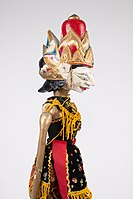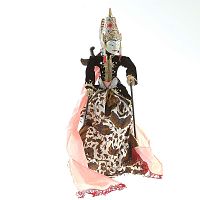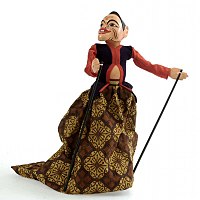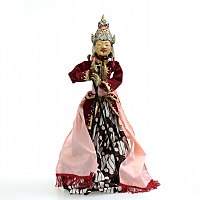
Gamelan is the traditional ensemble music of the Javanese, Sundanese, and Balinese peoples of Indonesia, made up predominantly of percussive instruments. The most common instruments used are metallophones and a set of hand-drums called kendang, which keep the beat. The kemanak, a banana-shaped idiophone, and the gangsa, another metallophone, are also commonly used gamelan instruments on Bali. Other notable instruments include xylophones, bamboo flutes, a bowed string instrument called a rebab, and a zither-like instrument called a siter, used in Javanese gamelan. Additionally, vocalists may be featured, being referred to as sindhen for females or gerong for males.

Puppetry is a form of theatre or performance that involves the manipulation of puppets – inanimate objects, often resembling some type of human or animal figure, that are animated or manipulated by a human called a puppeteer. Such a performance is also known as a puppet production. The script for a puppet production is called a puppet play. Puppeteers use movements from hands and arms to control devices such as rods or strings to move the body, head, limbs, and in some cases the mouth and eyes of the puppet. The puppeteer sometimes speaks in the voice of the character of the puppet, while at other times they perform to a recorded soundtrack.

Central Java is a province of Indonesia, located in the middle of the island of Java. Its administrative capital is Semarang. It is bordered by West Java in the west, the Indian Ocean and the Special Region of Yogyakarta in the south, East Java in the east, and the Java Sea in the north. It has a total area of 33,750.37 km2, with a population of 36,516,035 at the 2020 Census making it the third-most populous province in both Java and Indonesia after West Java and East Java. The official population estimate in mid-2023 was 37,608,336 The province also includes a number of offshore islands, including the island of Nusakambangan in the south, and the Karimun Jawa Islands in the Java Sea.

Wayang is a traditional form of puppet theatre play originating from the Indonesian island of Java. Wayang refers to the entire dramatic show. Sometimes the leather puppet itself is referred to as wayang. Performances of wayang puppet theatre are accompanied by a gamelan orchestra in Java, and by gender wayang in Bali. The dramatic stories depict mythologies, such as episodes from the Hindu epics the Ramayana and the Mahabharata, as well as local adaptations of cultural legends. Traditionally, a wayang is played out in a ritualized midnight-to-dawn show by a dalang, an artist and spiritual leader; people watch the show from both sides of the screen.

The culture of Indonesia has been shaped by the interplay of indigenous customs and diverse foreign influences. With over 1,300 distinct ethnic groups, including significant Austronesian and Melanesian cultures, contributing to its rich traditions, languages, and customs, Indonesia is a melting pot of diversity. Positioned along ancient trade routes between the Far East, South Asia, and the Middle East, the country has absorbed cultural practices influenced by Hinduism, Buddhism, Confucianism, Islam, and Christianity. These influences have created a complex cultural tapestry that often differs from the original indigenous cultures.
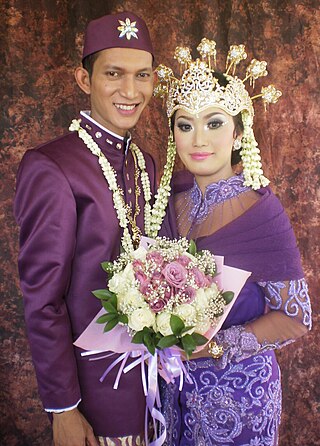
The Sundanese are an indigenous ethnic group native to the western region of Java island in Indonesia, primarily West Java. They number approximately 42 million and form Indonesia's second most populous ethnic group. They speak the Sundanese language, which is part of the Austronesian languages.

Shadow play, also known as shadow puppetry, is an ancient form of storytelling and entertainment which uses flat articulated cut-out figures which are held between a source of light and a translucent screen or scrim. The cut-out shapes of the puppets sometimes include translucent color or other types of detailing. Various effects can be achieved by moving both the puppets and the light source. A skilled puppeteer can make the figures appear to walk, dance, fight, nod and laugh.

Wayang wong, also known as wayang orang, is a type of classical Javanese and Balinese dance theatrical performance with themes taken from episodes of the Ramayāna or Mahabharāta. Performances are stylised, reflecting Javanese court culture:
Wayang wong dance drama in the central Javanese Kraton of Yogyakarta represents the epitome of Javanese aesthetic unity. It is total theatre involving dance, drama, music, visual arts, language, and literature. A highly cultured sense of formality permeates every aspect of its presentation.
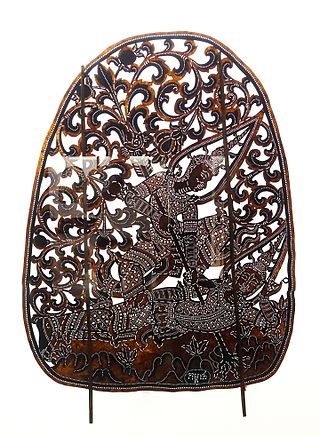
Khmer shadow theatre are forms of shadow play in which leather shadow puppets are used. The two main genres are Sbek Thom, which features the Reamker, and Sbek Toch, which uses smaller puppets and a wide range of stories. Another genre called Sbek Por uses colored leather puppets. The shadow plays of Cambodia are closely related to and also resemble the shadow plays of Thailand, Indonesia (Wayang and Wayang kulit). In Cambodia, the shadow play is called Nang Sbek Thom, or simply as Sbek Thom, Sbek Touch and Sbek Por.

Javanese dance is the dances and art forms that were created and influenced by Javanese culture in Indonesia. Javanese dance movement is controlled, deliberate, and refined. Javanese art often displays finesse, and, at the same time, a serene composure which is elevated far above everything mundane. Javanese dance is usually associated with courtly, refined, and sophisticated culture of the Javanese kratons, such as the bedhaya and srimpi dance. However, in a wider sense, Javanese dance also includes the dances of Javanese commoners and villagers, such as ronggeng, tayub, reog, and jaran kepang.

Cepot or Astrajingga is one of the wayang golek characters in Sundanese puppetry. Cepot is a punokawan alongside Dawala and Garéng, which do not exist in the original Mahabharata or Ramayana. Cepot is one of Semar's sons. Cepot is a rural character from the fictional village Tumaritis, where he lived with his father Semar and two of his brothers, Petruk and Dawala. Cepot is humorous and easy going, everything Cepot says tends to be funny, and Cepot's act has many slapstick jokes, mostly done together with its antagonist wayang golek character. Cepot in wayang golek puppetry also has other, good looking faces: Astrajingga, described with its straight, humble, good looking and white face. Cepot is the favourite character of Sundanese Indonesian wayang golek maestro Asep Sunandar Sunarya.

Sundanese dances is a dance tradition that is a part of ritual, artistic expression as well as entertainment and social conduct among the Sundanese people of West Java and Banten, Indonesia. Sundanese dance is usually cheerful, dynamic and expressive, with flowing movements in-sync with the beat of kendang accompanied with Gamelan degung music ensemble.
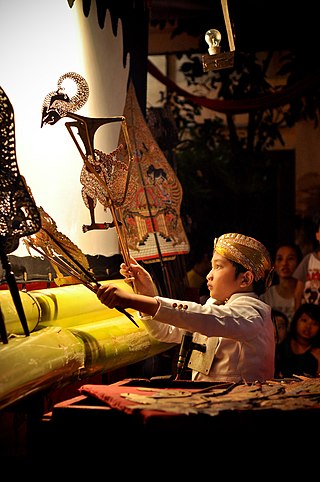
Wayang kulit is a traditional form of shadow puppetry originally found in the cultures of Java and Bali in Indonesia. In a wayang kulit performance, the puppet figures are rear-projected on a taut linen screen with a coconut oil light. The dalang manipulates carved leather figures between the lamp and the screen to bring the shadows to life. The narratives of wayang kulit often have to do with the major theme of good vs. evil.

It is quite difficult to define Indonesian art, since the country is immensely diverse. The sprawling archipelago nation consists of 17,000 islands. Around 922 of those permanently inhabited, by over 1,300 ethnic groups, which speak more than 700 living languages.
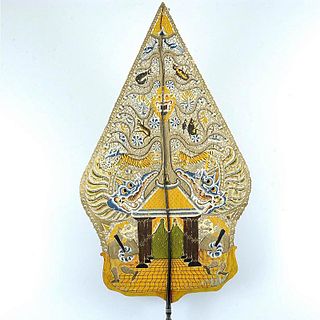
The gunungan, also known as kayon or kayonan in Bali, is a figure in the Indonesian theatrical performance of wayang e.g. wayang kulit, wayang klitik, wayang golek, and wayang beber.

Indra Swara is a group promoting Indonesian art and culture in Mexico. It was created in December 2002 and it is mostly made up of young Mexicans, enthusiasts of Asian arts and particularly those of Indonesia. Some of its members have had the opportunity to study directly in the islands of Java and Bali through the Darmasiswa Scholarship program offered by the Indonesian government.
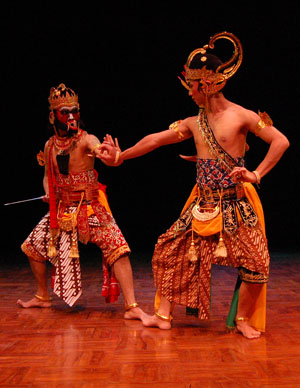
Bambangan Cakil is a classical dance-drama of Javanese people in—particularly—Central Java, Indonesia. This dance-drama demonstrates wayang performance due to the movement is adopted from one of the scenes in wayang kulit performance, that is the Perang Kembang scene. The Perang Kembang told about war between kesatria and raksasa. The kesatria has soft and gentle characters, while the raksasa is described as a character who is rough and violent.
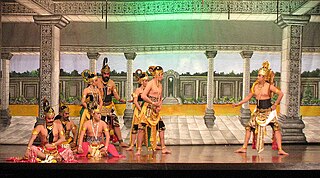
Indonesian theatre is a type of art in the form of drama performances that are staged on a stage, with a distinct Indonesian nuance or background. In general, theatre is an art that emphasizes the performing arts that are displayed in front of a large crowd. In other words, theater is a form of visualisation of a drama that is staged on the stage and watched by the audience. Indonesian theatre includes the performing arts of traditional theater and modern theatre located in the territory of Indonesia. Some examples of Indonesian theater are Arja, Wayang, Wayang wong, Lenong, Ludruk, Janger, Randai and others. Theatre in Indonesia can also be referred to as regional or ethnic theatre, because it originates and develops from 1,300 ethnic cultures in Indonesia.

Wayang beber is an Indonesian wayang performance art whose presentation is manifested in a stretch sheets of paper or cloth with pictures in the stylized wayang accompanied by a narration by a dalang. Wayang beber performances emerged and developed in Java in pre-Islamic times, but continued into the Islamic kingdoms. The stories shown are taken from the Mahabharata and the Ramayana. After Islam became the main religion in Java, more Panji stories were shown. Wayang beber bears a strong resemblance to narrative in the form of pictorial ballads common at annual fairs in medieval and early modern Europe. They too suffered the same fate—nearly extinct, although there are still groups of artists who support wayang beber in places like Surakarta (Solo) in Central Java.





